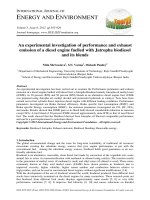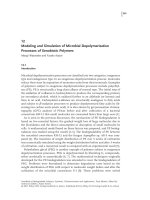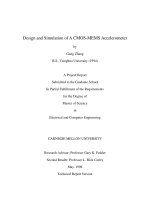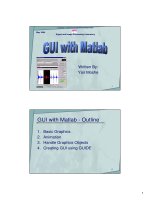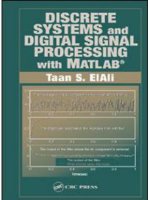business economics & finance with matlab gis and simulation models - patrick l.anderson
Bạn đang xem bản rút gọn của tài liệu. Xem và tải ngay bản đầy đủ của tài liệu tại đây (3.92 MB, 457 trang )
Business Economics and Finance with
MATLAB
®
, GIS, and Simulation Models
Business Economics and Finance
with MATLAB
®
, GIS, and
Simulation Models
Patrick L.Anderson
Principal, Anderson Economic Group
CHAPMAN & HALL/CRC
A CRC Press Company
Boca Raton London New York Washington, D.C.
This edition published in the Taylor & Francis e-Library, 2005.
“To purchase your own copy of this or any of Taylor & Francis or Routledge’s collection of
thousands of eBooks please go to
Library of Congress Cataloging-in-Publication Data
Anderson, Patrick L. Business economics and finance with MATLAB, GIS and simulation
models/Patrick L. Anderson. p. cm. Includes index. ISBN 1-58488-348-0 (alk. paper) 1.
Managerial economics—Mathematical models. I. Title.
HD30.22.A53 2004 338.5′01′13–dc22 2003069765
This book contains information obtained from authentic and highly regarded sources. Reprinted
material is quoted with permission, and sources are indicated. A wide variety of references are
listed. Reasonable efforts have been made to publish reliable data and information, but the author
and the publisher cannot assume responsibility for the validity of all materials or for the
consequences of their use.
Neither this book nor any part may be reproduced or transmitted in any form or by any means,
electronic or mechanical, including photocopying, microfilming, and recording, or by any
information storage or retrieval system, without prior permission in writing from the publisher.
The consent of CRC Press LLC does not extend to copying for general distribution, for promotion,
for creating new works, or for resale. Specific permission must be obtained in writing from CRC
Press LLC for such copying.
Direct all inquiries to CRC Press LLC, 2000 N.W. Corporate Blvd., Boca Raton, Florida 33431.
Trademark Notice: Product or corporate names may be trademarks or registered trademarks, and
are used only for identification and explanation, without intent to infringe.
Visit the CRC Press Web site at www.crcpress.com
© 2005 by Chapman & Hall/CRC Press LLC
No claim to original U.S. Government works
ISBN 0-203-49465-2 Master e-book ISBN
ISBN 0-203-59406-1 (Adobe e-Reader Format)
International Standard Book Number 1-58488-348-0 (Print Edition)
Library of Congress Card Number 2003069765
Dedication
This book is dedicated to the memory of Lt. Robert Regan and firefighters Joseph
Agnello and Peter Anthony Vega, who fell in the line of duty on September 11, 2001,
rescuing people in the Marriott World Trade Center—including the author, who is
forever indebted.
Acknowledgements
This book would not have been completed without the assistance of the following people:
David Littman, who mentored me for three critical years early in my career, and
whom I consider the dean of American business economists.
Ian Clemens, who first introduced me to MATLAB and who helped develop some of
the routines for gravity models, sprawl, and diversificiation presented here.
Ilhan Geckil and Chris Cotton, who worked with me on a number of projects
excerpted here, including fiscal and economic model analyses of retail sales.
Christine LeNet, who both reviewed the content in the business, tax policy, and other
chapters, and formatted figures and document files for publication.
Arianna Pieper and Megan Boone, who formatted, corrected, adjusted the figures, and
checked the manuscript—and provided an occasional polite recommendation that I
rephrase a few things.
Vlad Hlasny, Dan Li, Kevin Dick, Michael Robbins, Raymond Neveu, Jay Abrams,
and Ralph Sandler, who provide invaluable review comments on earlier manuscripts.
Bob Stern of CRC Press, who was supportive, encouraging, and politely insistent on
getting this project done.
Finally, my wife, Madhu, and our children Neal, Sean, and Mohra endured many
evenings, late nights, and long days without me while I labored on the text, especially the
past year. It has been a long journey, but not a lonely one for an author much blessed with
a wonderful family.
Table of Contents
Table of Contents
ix
List of Tables
xi
List of Figures
xiii
List of Code Fragments
xvii
1
How to Use This Book
1
2
Mathematical and Simulation Models in Business Economics
16
3
MATLAB and Simulink Design Guidelines
26
4
Importing and Reporting Your Data
53
5
Library Functions for Business Economics
83
6
Economic Impact Models
110
7
Fiscal Impact Models
137
8
Tax Revenue and Tax Policy
149
9
Regional Economics
164
10
Applications for Business
182
11
Business Valuation and Damages Estimation
211
12
Applications for Finance
262
13
Modeling Location and Retail Sales
286
14
Applications for Manufacturing
331
15
Fuzzy Logic Business Applications
341
16
Bringing Analytic Power to the Internet
360
17
Graphics and Other Topics
376
Appendix A
: Troubleshooting
400
Appendix B
: Excel Link Debugging
405
Index
408
List of Tables
Theoretical vs. Applied Economics
17
When to Use Simulation Models
24
Major Style Elements for Simulink Models
36
Styles for Specific Blocks
38
Key Simulation Parameters
42
Sample Excel Sheet for Inputting Data
62
Economic Impact of the Fantasy Game
117
Gross and Net Costs of a 25% Michigan State EITC
158
Standard Measures of Diversification
179
Concepts of Value in Accounting and Economics
215
Cost of Capital Estimates for Small Beer Distributors, 2003
242
Input Sheets for Individual Distributors
243
Questions for Audit Predictor
347
Waves of Internet Functionality
361
Actual and Visual Impression of Data
381
List of Figures
Simulink Model Example: House Net Benefits
32
Costs and Rental Value Subsystem
33
Simulink Model Example: Cost Shares Subsystem
34
Simulink Model Example: Cost Subsystem
35
Top-level view of Simulink Model
37
Initialization Block in a Simulink Model
41
Linear Demand Function
91
Supply Schedule
92
Elasticity of Supply Schedule
93
Demand and Supply Graph
95
Elastic Impact Block
99
Example Business Economics Model
101
Base Income Subsystem
102
Policy Change Subsystem
102
Income and Sales Subsystem
103
Sales Projection with Policy Change
103
Fiscal and Economic Impact Model
132
Population Migration Subsystem
133
Tax Revenue Subsystem
133
Municipal Costs
143
Cost and benefit
144
Fiscal Model Schematic-I
145
Fiscal Model Schematic-II
145
Fiscal Model Schematic-III
146
Effective Tax Rates, Selected Income, and Payroll Taxes
155
Total Tax Rates on Wage Income
156
Fiscal Estimation Model
157
Gross and net costs of Michigan EITC by year
158
Selected Diversification Measures
166
Employment Risk and Reward
170
Frontier of Risk and Return
173
Sprawl Indices for Various Cities
176
Trend Projection Graphic
184
Income Statement
201
Earnings Subsystem
201
Depreciation and Amortization
201
Iterative Model: Overview
203
Iterative Model: Operating Expenses
204
Iterative Model: Tax Subsystem
204
Iterative Model: Convergence of Tax and Value Variables
205
Plausible Values from Valuation Command
249
Mortgage Analysis
265
Auto Depreciation: Double Declining Balance
267
Auto Depreciation: Half-Year Convention, Modified Accelerated
Cost Recovery System (MACRS)
268
Auto Depreciation: Long-lived Vehicles
269
Return & Volatility Percent Analysis
271
Comparison of Price Changes
272
Drive-Time Analysis
300
Equal-Distance Rings
301
Sales Patterns and Distance
302
Sales Patterns and Distance: Alternative Perspective
303
Market Penetration Rate
304
Daylight Areas
305
Underlying Sales-Distance Relationship: Gravity Model
313
Estimated Sales-Distance Relationship
314
Distance-Sales Relationships for Automobile Dealers
315
Gravity vs. Polynomial Specifications
318
Xbar Chart
334
S Chart
354
Capability Chart
336
Graphical Display of Audit Predictor
350
Income Membership Functions
351
Audit Flag Membership Function
352
Surface of Rules
353
Ruleviewer for Audit Risk FIS
353
Credit Risk Simulation Model
356
3-D Graphic of Sales and Income Data
379
Proper Display of Underlying Data
380
Line Graph
384
Pie Chart
385
Bar Chart
387
Time Series Analysis
389
Growth Chart
390
List of Code Fragments
A Simple Startup File
6
Display command in masked subsystem
39
Help information in masked subsystem
40
Setting parameters for blocks
40
Self-describing variable for blocks
41
Setting the Source Workspace
43
Setting Time Parameters
43
Setting Options and Simulating Model
44
Messages in a Callback
46
Character Arrays
46
Character and Cell Array Displays
47
Library Blocks
48
Master Simulation Callback
49
URLREAD for Direct Internet Data Access
60
Entering String and Numeric Data Arrays
64
Cell Arrays
65
Structure Syntax
66
Creating, Packing and Unpacking a Structure
67
Saving Structures to a .mat File
69
The Info.xml File for the Economics Toolbox
74
Creating a Valuation Data Structure
76
Simple Linear Demand Function
104
Supply Function
105
Declaring An Economics Block Library
108
Fiscal Impact Callback
146
Social Security Tax
159
Federal Income Tax Calculator
160
EITC Master M-file Code 162
Trend Projection Function 205
Trend Projection Output 206
Ito Process Projection 207
Projecting Jump Processes 208
Simulation Callback for Iterative Tax Model 208
Input List for Valuation Function 241
Valuation Session for Beer Distributors
257
Valuation of Beer Distributors Function
258
Mortgage Calculator
274
Auto Depreciation
276
Get Stocks Function
279
Test Gravity Model Output
313
An SPC Demonstration Routine
339
Audit Predictor Rules
348
Read FIS Command
357
Fuzzy Logic Audit Risk
358
Using XML to Generate Help Files
372
Info.xml file for Economics Toolbox
373
Testplot: Line Chart
390
Testplot Function
391
Testplot: Adjusting Axes
392
Testplot: Pie Chart
394
Testplot: Bar Graph
396
Testplot: Sub-Plots
398
1
How to Use This Book
Organization of the Book
This book is organized into chapters, each covering a topic. Sections in each of the
chapters describe in more detail one aspect of the topic. Most readers will want to read a
few chapters immediately and then return to cover specific topics as their interests
warrant.
The chapters proceed as follows:
1. The first chapter describes the organization and purpose of the book as well as how to
acquire the business economics toolbox prepared by the author for readers of the book.
It also provides certain maxims of business economics. Almost all readers will want to
review this chapter first.
2. The second chapter contrasts business economics with academic economics and
discusses why simulation models in general, and MATLAB and Simulink in
particular, offer advantages to the practicing economist.
1
Most readers will benefit
from this chapter.
3. The third chapter describes the MATLAB and Simulink environment and provides
guidelines for creating and using models in this environment. Style guidelines are
presented that help make such models easier to understand and debug.
4. Chapter 4 focuses on data. We present methods to get your data into the MATLAB
environment and to report it out. The chapter also contains a specific introduction to
the use of Microsoft Excel as an environment for easily collecting, importing, and
reporting data. Three appendices to this chapter discuss XML and structured data,
creating and using custom data structures, and also importing files of various formats.
Most readers will again benefit from these chapters, although those with some
familiarity with the MATLAB environment will skim portions of them.
5. The fifth chapter discusses certain building blocks of economic analysis used in
economics and then provides custom-programmed functions and models which
implement these tools. These tools form the basis of the economics toolbox created for
readers of this book. The chapter also discusses creating and using a library of such
functions. This chapter introduces material not available in any other form and will be
essential reading for those who wish to implement the models described later in the
book.
1
MATLAB® and Simulink
®
are trademarks of The Mathworks, Inc., 3 Apple Hill Drive, Natick,
MA 01760.
6. The chapters that follow describe specific fields of application:
a. Economic and fiscal impact models as well as tax policy and forecasting tax
revenue are covered in Chapter 6, Chapter 7, and Chapter 8. These chapters provide
practitioners in these fields with advanced tools that enable more accurate, reliable
analysis. The first sections of the chapter on economic impact models identify the
severe weaknesses in many common economic impact reports, adding in some
examples of particularly absurd gross exaggeration in published reports. These
sections close with a plea for ethics in that subfield. As much of our work has been
in public policy, we use these tools on a regular basis and hope that the analytical
tools will help improve the level of analysis and that our admonitions about ethics
in using them will not fall on deaf ears.
b. Regional economics is discussed in Chapter 9, particularly the proper analysis of
economic diversification for states or regions and a rigorous discussion of urban
sprawl. In the first sections, we present techniques that have been recently
developed and provide a much better concept of risk and return in regional
economies than naive diversification analyses that are not grounded in a rigorous
theory of economic growth and variation among industries. In the second section, a
numerical sprawl index is presented for the first time in print.
c. Chapter 10, Chapter 11, and Chapter 12 cover the economics of a firm. Chapter 10
describes modeling a firm, focusing on the crucial question of how a firm makes
money. An iterative method of matching market value and expenses based on value
is introduced. Chapter 11 discusses business valuation, noting the various methods
used to estimate the value of a business and the various definitions of value. The
chapter differs from most other references in this field in two ways: first, we
concentrate on what we consider the most important consideration in the market
value of a company, namely its prospects for future earnings; and, second, we
utilize the greater analytical power of quantitative models that the MATLAB
environment provides.
d. Retail sales are discussed in Chapter 13. Much of the material presented here,
including the derivation of the distance-sales relationship from microeconomic
foundations, is unique to this book. Other portions provide craft knowledge of this
interesting field that is rarely described in print.
e. Chapter 14 briefly covers statistical process control techniques in manufacturing—a
topic that is less well known than it should be among business economists and
managers, given its importance.
f. Fuzzy logic models are introduced in Chapter 15. Fuzzy logic is actually quite
rigorous, though the name it has been given may be inhibiting its adoption as a
powerful tool for incorporating various types of inf formation, including vaguely
defined or subjective information, into a rigorous inference system.
g. Chapter 16 deals with using MATLAB and Simulink with the Internet and includes
suggestions on analytical applications on the Web, sharing and displaying
information, and the use of the MATLAB Web server. This is optional reading for
many readers, but it contains unique material for those who wish to advance to the
state of the art for analytics and data transfer on the Web.
h. The last chapter contains extensive information on the proper use of graphics to
communicate data and specific MATLAB code to generate and customize a
Business economics and finance 2
number of charts. The chapter starts with a review of the classic rules for graphical
excellence and descriptions of the all-too-common graphical errors such as
“chartjunk” and distortion due to improper use of 3-D graphics. There are very few
texts in the social sciences which offer guidance in the proper use of graphics, and
we intend this to be one.
7. Each of these chapters describes briefly the theory behind the models and then outlines
an approach. These chapters can be read, skimmed, or skipped, depending on the
interest at hand. A reader dealing with a finance problem, or one interested in fuzzy
logic applications, could jump right to this chapter (after, of course, reviewing the
initial chapters) without necessarily reading up on economic or fiscal impact models.
Numerous cross-references indicate where similar or extended material appears
elsewhere in the book.
8. The appendices contain troubleshooting suggestions that could save you a lot of time
and trouble.
Intended Audience
This text is primarily designed for two audiences:
1. Economists, finance and valuation professionals, market researchers, public policy
analysts, and other practitioners whose occupation demands the ability to model
market behavior under a variety of real-world conditions
2. Teachers or students in graduate-level classes in applied economics, particularly those
who cover topics such as fiscal and economic impact analysis, fuzzy logic
applications, retail sales analysis, and the integration of geographic information
systems, as this is one of the very few books to rigorously cover these subjects
The book may also be used by those interested in specialized topics rarely covered in
economics texts, such as those listed above, and by those who have extensive background
in mathematical or simulation models (such as MATLAB and Simulink) and wish to
extend their knowledge.
Prerequisite Knowledge
We presume the reader has the following knowledge:
1. A good grounding in the laws of microeconomics and a familiarity with their
application. Most practitioners and graduate students in economics, finance, public
policy, and related disciplines should either be able to acquire this or should have
already done so. Most undergraduates will need additional training.
2. A working understanding of mathematics, including (for some chapters) an
understanding of the calculus used in comparative statistics. The completion of a
graduate course in math for economists would be helpful, but is not mandatory.
3. For many of the chapters, a familiarity with (but not necessarily expertise in) the
MATLAB software environment. Most of the applications presented here could be
How to use this book 3
accomplished in other software environments, but we provide examples of
applications in MATLAB. See “References on MATLAB and Applied Economics” on
page 9.
4. For some chapters, an awareness (but not necessarily a working knowledge) of
geographical information systems.
We suggest some resources on these topics under “References on MATLAB and Applied
Economics” on page 9.
Suggested Reading Plans
The organization of this book allows you to read those portions most relevant to the work
you are doing at present, in particular:
• Regardless of whether you are new to business economics or a veteran, read the brief
“Maxims of Business Economics” on page 15.
• If you are new to the use of simulation models, it is best to start at the beginning. Go
through the chapters that explain the MATLAB and Simulink environment, how to get
your data, and creating and using library functions. Then jump to the most interesting
application chapters.
• If you are focused on one type of application and have a working familiarity with
MATLAB or Simulink, finish this chapter and then jump straight to the application
chapters. Be prepared to review information in the earlier chapters or in the
appendices.
• If you are currently using MATLAB or Simulink and are looking for suggested
approaches or troubleshooting information, scan the chapters on troubleshooting in the
appendices, any relevant application chapters, and the early chapters on design
guidelines, getting your data, and library functions.
• If you want to learn about using MATLAB and Simulink on the Internet, jump to that
chapter but be prepared to refer to other areas.
Typographic Conventions
We have adopted certain typographic conventions that will assist the reader in
understanding the text, such as:
• The main text of the book is written in a normal font, like this.
• Text that is part of a computer program or is a command you type in a software
environment is in a keystroke font.
• Program commands for software that uses menus are sometimes summarized by listing
the menu selections that execute them with the piping separator (“|”) between the
menu selections. For example, to use the MATLAB menu command to open a new
Simulink model, you would execute the following menu items:
1. First, hit the File menu with your mouse or with a keyboard command (such as Alt-
F).
Business economics and finance 4
2. Second, hit the New submenu command on the File menu.
3. Third, select Model from the File submenu.
We summarize this set of commands as: File|New|Model.
Changing Software Commands
Keep in mind that software companies change the menus in their products frequently, and
you may need to use a different set of commands if you are using a different version of
the software or on a different operating system. Also, there may be a shortcut method
using a combination of keystrokes or mouse actions that can accomplish the same
operation in a different way.
MATLAB Programming and Code
We have provided the actual code for a number of MATLAB programs we have prepared
to illustrate the techniques described in this book. Longer sections are listed as the code
fragment “A Simple Startup File” on page 7.
2
We call these code fragments because they
are written in a specific software language or code, and because many of the longer code
sections are shortened, the code included in this text may be only a portion or fragment of
the entire file.
Main Purpose of Code
Experienced MATLAB users will undoubtedly notice ways in which the execution of
these programs could be speeded up or different ways of accomplishing the same thing.
The primary purpose of including the programs is to demonstrate how to perform certain
tasks and not to execute those tasks with maximum efficiency. Therefore, you will note
that many of the programs include extensive comment lines (which begin with a percent-
sign [%] mark) that are ignored by the computer. If you are reviewing these code
fragments in order to perform a similar task, pay attention to these comment lines. Those
who can recommend a more efficient—or more effective—code to accomplish the same
result are encouraged to send a note to the author. See the contact information at
“Contacting the Author” on page 9.
Version Notes
The versions of MATLAB used during the development of this book included R11, R12,
R13, and a prereleased version of R14. We believe that all of the routines will run, in
some cases with minor modifications, on R12 and R13. Most will run on R11 as well.
Based on our testing of the comparison business economics toolbox with the prereleased
version of R14, we anticipate that all of the routines included here will also work under
2
A startup file is a set of instructions run by MATLAB when the program is first run. We
recommend that users customize their startup files; this is discussed in Chapter 3, this book, under
“Setting Up the MATLAB Workspace” on page 30.
How to use this book 5


